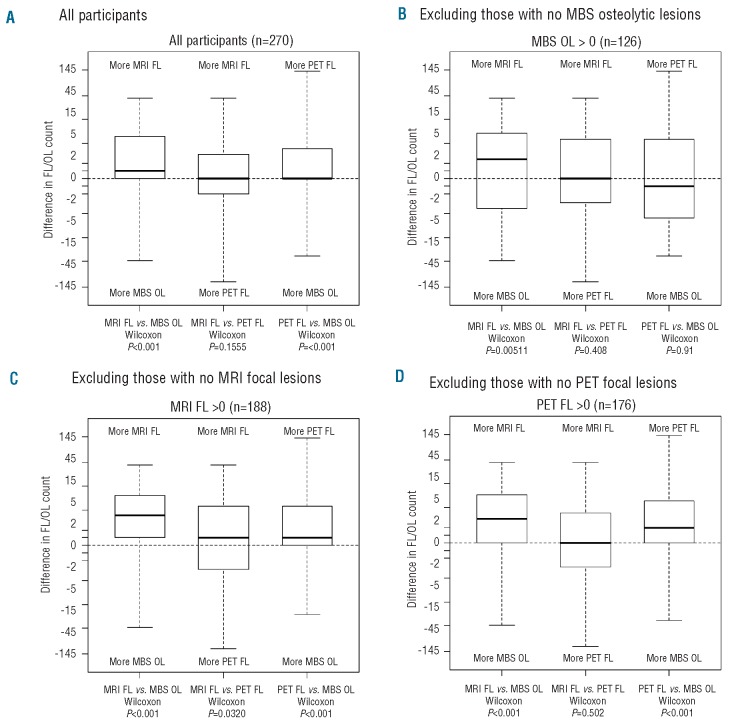Figure 2.
Log odds ratios measuring the association of baseline prognostic factors with imaging parameters at baseline. DHIM comparisons were limited to the subset of participants with no detected MRI-FLs (n=82 for standard laboratory and imaging variables and n=74 for GEP variables). (A) MBS and MRI. Left: both MBS-OL cut-off points were correlated with both cut-off points for MRI-FL and PET-FL. Among GEP variables, high risk (70-gene model), PR subtype, and CI, all reflecting disease aggressiveness, were significantly linked to more than 2 MBS-OLs. DelTP53 was neutral relative to MBS-OLs. Among standard laboratory prognostic variables, high serum levels of β2M (>5.5 mg/L) were associated with more than 2 MBS-OLs. Middle: for both MRI-FL cut-off points, there were strong positive correlations with MBS-OLs and PET-FLs, but not with PET FL-SUV, EMD, or SUVdiff. Among GEP features, PI and CI positively correlated with MRI-FL >7. Among GEP-defined molecular subgroups, the PR subgroup positively correlated with MRI-FLs. Both MRI-FL cut-off points correlated with high-risk scores from the 70-gene model, but only the higher cut-off point (>7) was linked to high-risk scores from the 80-gene model. Among standard laboratory prognostic variables, CRP had significant positive correlations to MRI-FL >7. Right: for the subset with no MRI-FL, DHIM was associated with increased LDH and β2M. The comparison of GEP-80 risk groups was not possible because of the small number of GEP-80 high-risk subjects. Some parameters could not be estimated due to small sample sizes or association by definition (for example, MRI-FL >7 vs. MRI-FL >0). (B) PET. Left: PET-based FL number was examined for correlations with other imaging parameters, standard laboratory prognostic variables, and GEP variables. At both cut-off points (>0 and >3), PET-FLs had highly significant positive correlations with MBS-OLs and MRI-FLs. GEP-derived variables that were significantly positively associated with PET-FL included high-risk myeloma defined by the 70-gene model as well as PI and CI. Among GEP-defined molecular subgroups, the PR subgroup showed positive correlation and the LB subgroup negative correlation to PET-FLs. Among standard laboratory prognostic variables, elevated CRP and LDH were seen more often with more PET-FLs. Middle: PET FL-SUV was highly associated with more than 3 PET-FLs, high-risk disease (70-gene model), and SUVdiff. Right: PET-EMD was linked to high β2M. Comparison of the CD-1 sub-group versus all other GEP subgroups was not possible because of the small number of CD-1 subjects.

